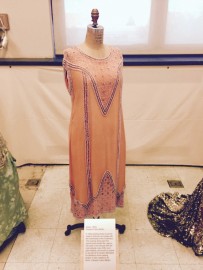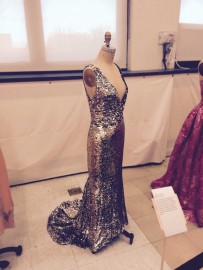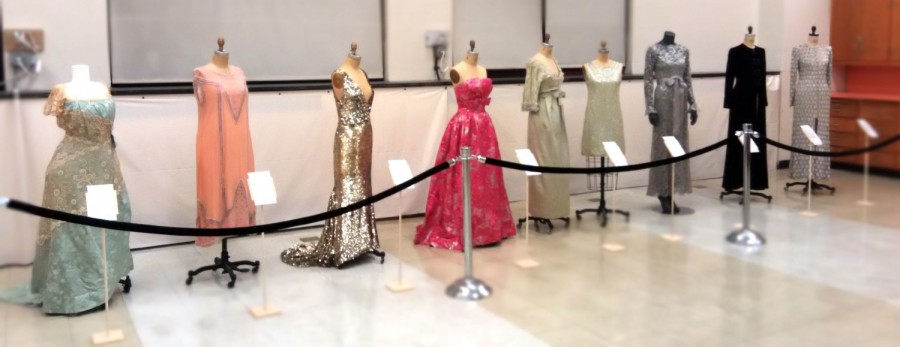Queens College Historic Costume Collection
Text and photos by Brenna Boone
The featured garments, for the event at Queens College as a part of the Tuttotoscana program, had a focus on the 20th century with the earliest piece coming from 1910. The nine garments selected for “A Night Out”, the title of the exhibit, were among the most stunning and lavish gowns from the entire collection. Famous designers such as Oscar de la Renta, Yves St. Laurent, Herbert Sondheim and others created most of these couture gowns.
The first gown of the collection, however, has an unknown designer. This dress is from 1910 and has a delicate lace with embroidery over a pale green floral fabric. This dress has soft features and detailed beading and embellishments. This dress would be seen in the in the Edwardian Era and also during the time of the Titanic.
 The next selected garment for the collection is from the 1920s by Olympia Cutino Medici and has a peachy-pink tint to it and pale beading. The beading would is not a propionate feature, but instead an addition that adds shimmer and sparkle as one moves in the dress.
The next selected garment for the collection is from the 1920s by Olympia Cutino Medici and has a peachy-pink tint to it and pale beading. The beading would is not a propionate feature, but instead an addition that adds shimmer and sparkle as one moves in the dress.
 The third dress shown from the collection is from the 1930s. This dress has a deep plunge V-neck line, with dazzling gold sequins to coat the entire gown. To leave a sparkle wherever it is worn it has a train that drapes onto the floor behind the dress. This timeless dress literally sparkles wherever it is worn and is sure to continue to be a showstopper.
The third dress shown from the collection is from the 1930s. This dress has a deep plunge V-neck line, with dazzling gold sequins to coat the entire gown. To leave a sparkle wherever it is worn it has a train that drapes onto the floor behind the dress. This timeless dress literally sparkles wherever it is worn and is sure to continue to be a showstopper.
The fourth dress shown from the collection is pink and silver with a silhouette that exaggerates the waist to hip ratio with a tight fitting corseted top and a voluminous bottom. The silver detailing on the dress was made with aluminum thread, which, ironically, was created by a worker of the Alcoa Aluminum Company.
The next dress in the collection is from the early 1950s by Bob Bugnand. This dress also features a pale green color with bold clear beading aligning another deep-V neckline.
The sixth gown is from the mid 1960s by an unknown French maker. This is a mini dress that is a light sea-foam green color with complete coverage in small delicate beading. This is another dress that sparkles and shines as it is worn.
The seventh gown shown from the collection is an all grey lace dress with a silk-statement bow at the waistline. A special element about the lace featured in this dress is that it also has a shimmer quality to it.
The eighth gown in the collection is from 1996 by Oscar de la Renta; it was originally described as pajamas but later worn as a couture dress. One of the main features of this gown is the fabric, which was a dark red and black floral velvet fabric.
The final dress in the collection, and one of the stars of the show, was made in 2001 by Oscar de la Renta for Balmain. This dress is an incredible work of art because of the high level of detail and precision that went into the embellishments. The gown features a velvet diamond and beading pattern with every diamond and bead hand sewn onto a very delicate lining.
The Queens College Historic Costume Collection is home to many dazzling garments, textiles and accessories spanning through the early 1700s to the 21st century. To keep such delicate materials from deteriorating and disintegrating there are certain climate, and storage conditions that the costume collection must be kept in; this includes controlling the humidity and temperature of the room they are in. Some of the garments in the historic collection are very delicate because of the materials and because they are couture. Couture items are typically entirely handmade, with lots of labor-intensive details. Some typical embellishments shown on couture items include the addition of sequins, beading, embroidery and appliqué; most of which are added individually by hand. The time and details that go into every couture item is what makes them so stunning and special.
